Museum Workers Across the Country Are Unionizing. Here’s What’s Driving a Movement That’s Been Years in the Making
“Let us in! Let us in!” chanted a small crowd of visitor services associates dressed in black. They stood at the locked gate of the Marciano Art Foundation (MAF) on Friday, November 8, at 11 a.m., the time the museum normally would have opened to the public. Three days earlier, the austere contemporary art foundation had closed abruptly—less than a week after the visitor services associates announced their plan to unionize.
The foundation, a private nonprofit opened in early 2017 by the two art-collecting brothers behind the denim brand Guess, initially released a statement saying they were “supportive of all recommendations to improve the workplace.” But several days later, the administration sent out an email with a very different message: they would be “laying off all visitor service associates” and closing the current exhibition nearly one month early due to “low attendance.”
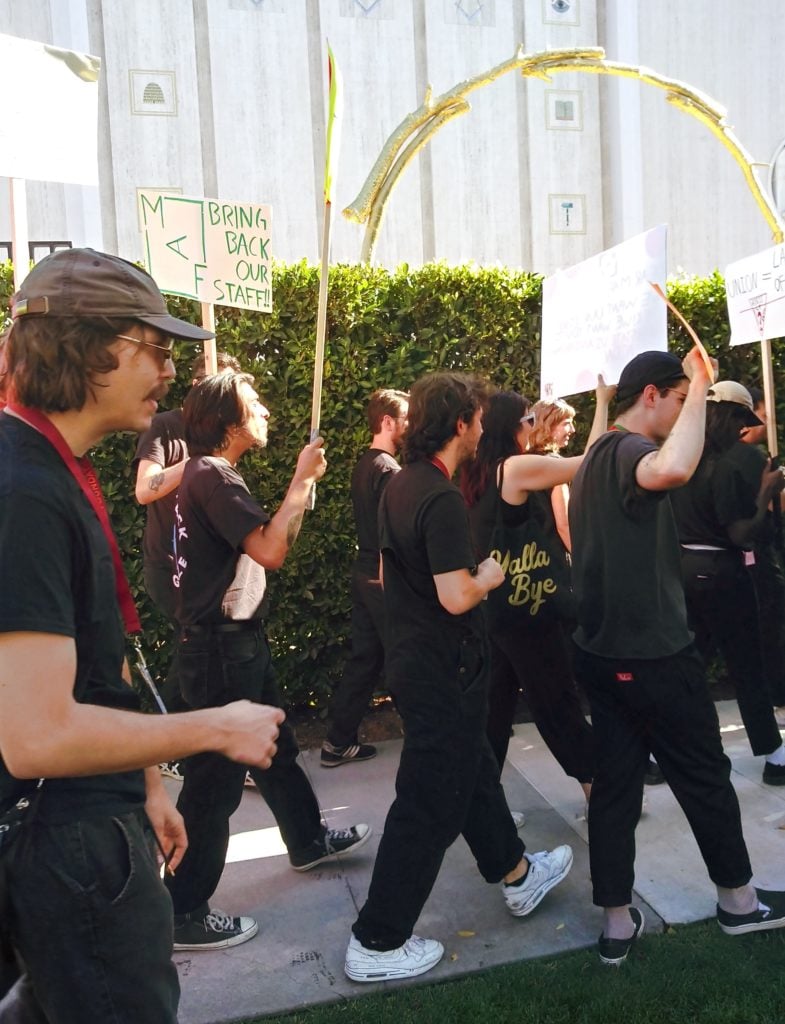
Workers march outside of the Marciano Foundation in Los Angeles. Photo: Catherine Wagley.
After filing a complaint with the National Labor Relations board, the just-formed union returned to their former workplace with colorful signs. “We want to work!” they chanted forcefully at the locked gate. (Their action wasn’t without its humor—“We want to see the Alex Israel,” called someone in the crowd, referring to the clichéd installation of palm trees and parking meters on the museum’s mezzanine. “Ewww,” someone else responded.)
A Growing Wave
The employees knew, as they moved to unionize, that they were part of a bigger, industry-wide conversation. The New Museum, the Solomon R. Guggenheim Museum, the Museum of Tolerance in Los Angeles, and the Frye Art Museum in Seattle have all formed unions this year.
And the tide doesn’t seem to be slowing: On November 22, a group of workers from Los Angeles’s Museum of Contemporary Art across multiple departments—exhibitions, education, communications, and audio-visual—followed suit. (Notably, Maurice Marciano, one of the brothers behind the MAF, is a board member emeritus at MOCA, and director Klaus Biesenbach’s full title is technically “the Maurice Marciano director.”)
The forces driving this push—ranging from a mandate to diversify staff to the rising cost of living in urban centers—are not necessarily specific to the art world. Similar efforts have rippled through higher education, as adjunct professors organize, and across the publishing industry.
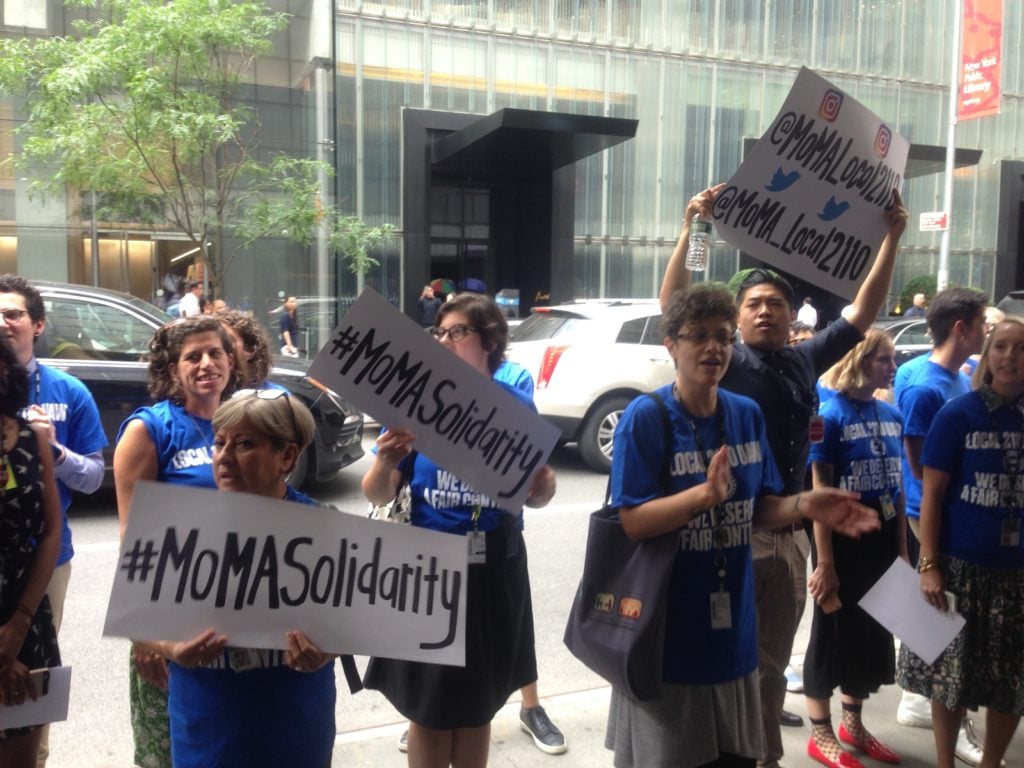
MoMA union worker protest at the Museum of Modern Art. Photo by Sarah Cascone.
But art is a field in which some of the world’s wealthiest people regularly interact with artists and workers hovering near the poverty line. Because of this wealth gap, and because art institutions regularly celebrate critiques of capitalism and power abuses in art while failing to engage with the concerns of their own low-paid employees, unionization feels like a critical culture shift.
What makes this shift a “movement not a trend”—according to the meme multiple art museum unions posted in the past week, rejecting the use of the word “trend” by press outlets and museum administrators—is the fact that workers from across different institutions, many of whom had not spoken to one another in the past, are exchanging strategic advice and sharing information about pay and benefits. In the process, they are attempting to thwart the art world’s own exclusivity in a way that could have lasting and widespread impact.
Information Sharing
Visitor services associates at MAF make $14.25 an hour, minimum wage in Los Angeles, but their job involves overseeing the galleries while acting as gallery educators and security. (The trend for this dual role began at the Broad, a non-profit museum founded by billionaire collector Eli Broad, which hired personable, art-aware quick-learners to protect the art while also engaging the public when it opened in 2015.)
When MAF’s visitor services associates decided to unionize, they reached out to the New Museum union, which announced its formation in January. “The New Museum was sort of our direct Dharma transmitter as it were,” said Eli Petzold, an organizing member of the MAF union.
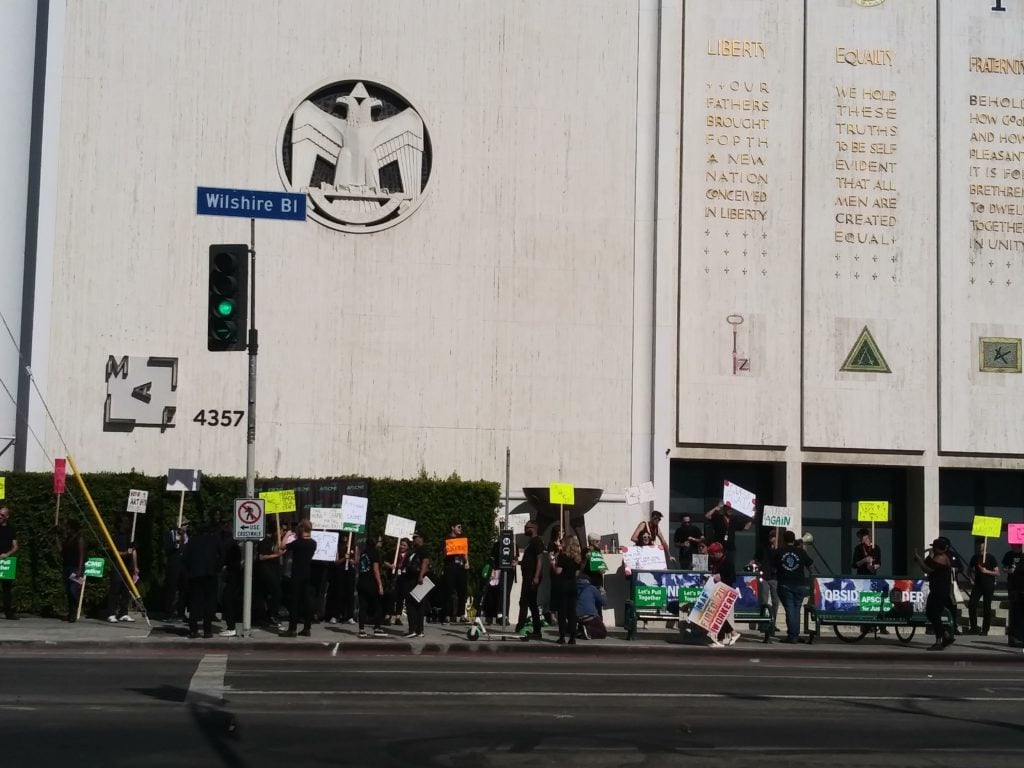
Protests outside of the Marciano Foundation in Los Angeles. Photo: Catherine Wagley.
This kind of information sharing has been critical to the formation of museum unions. Dana Kopel, one of the New Museum union organizers who stayed in touch with the MAF staff, said that she and her colleagues decided to unionize themselves after reaching out to a steward at the Museum of Modern Art’s union, who put them in touch with United Auto Workers’ Local 2110. The union’s president, Maida Rosenstein, brought members of MoMA’s union with her to meet New Museum staff. When the New Museum began contract negotiations, the MoMA union brought over snacks and Advil. “It was very sweet,” Kopel said.
Abigail Entsminger, an artist and art handler involved in the Guggenheim’s effort to unionize, said that the Guggenheim’s move was partly spurred by the large number of freelance art handlers working there, many of whom encountered similar labor conditions across the New York art world. “I think we’re all a little bit frustrated with the state of having to advocate so strenuously for ourselves in this industry,” she said.
As the Guggenheim began the process, reps from the International Union of Operating Engineers Local 30 would occasionally bring to meetings workers from PS1 or the Whitney, who would share their experiences. But the negotiations themselves often felt particular to the Guggenheim’s culture and management. “It’s hard in the moment, when you’re trying to actually do all of those nitty-gritty, very specified things, to think about it as a larger conversation,” Entsminger said.
Too Special for Unions?
This issue—whether art museums are too particular, too unique to integrate unions the way other workplaces do—is at the heart of the debate between union supporters and opponents.
After Guggenheim workers voted to unionize over the summer, Richard Armstrong, the Guggenheim’s director, emailed prepared remarks to staff, reiterating the museum’s specialized identity. “I do not want to work with a third party who has very limited experience in the museum field, and whose membership is largely in the heating and air-conditioning and construction industries,” Armstrong wrote. A spokesperson for the Guggenheim, which is now in contract negotiations with the union, declined to comment on whether the institution’s perspective had changed.
But Armstrong’s opinion is hardly isolated. In the wake of MOCA’s announcement, a representative for the museum said in a statement: “While we respect the right of employees to decide whether or not they wish to be represented by a union, we do not believe that this union is in the best interest of our employees or the museum.” Back when the New Museum announced its intention to unionize in January, the museum adopted a similar position, arguing that a union would threaten “what is special about our culture.”

The Guggenheim Museum with the logo for the IUOE Local 30.
Joseph Rosa, CEO and director of the Frye, acknowledged that “the movement is not just related to the organizations themselves but is tied to the bigger picture of the cities and systems that we are all working within.” But he added: “There is an important distinction to be made between a nonprofit museum, like the Frye, and for-profit businesses—they are not financially comparable.”
Maida Rosenstein, president of UAW Local 2110 (which represents MoMA and New Museum workers), thinks the assertion that art museums are too specialized for something as populist as unions is “just absurd.” “If you want to, as a worker, have any voice in your terms and conditions, then unionizing is the only way to do that,” she said.
Rosenstein, who became a union organizer after helping to unionize her own office at Columbia University in the 1980s, has worked with many white-collar professionals over the years. She does not consider the current growth in art museum unions an isolated trend. “The context is these urban centers, where workers working for employers that were not traditionally unionized are trying to unionize because wages are really low,” she explained, “and people are coming out of school with loads of debt and they’re working living in cities where the rent is incredibly high.”
The History
Even widespread acknowledgement that the art world is not unique represents a cultural shift for an industry that has long banked on its exceptionalism. When MoMA, which now has five unions, established its first in 1970 as an outgrowth of the Art Workers’ movement in New York, their language and goals resembled what is being said now. Workers cited concerns over low pay, but also over corrupt museum management. “The museum has for too long been a private toy when it should be a public institution!” cried one protester at MoMA’s 1971 strike, according to New York Times reporter Grace Glueck.
Glueck implied, in her coverage of the strike, that other museum workers nationwide were taking note. MoMA’s new contract, Glueck wrote, “should give pause to die hard trustee boards,” since “xpressions of interest have poured in.” Instead, the movement seemed to start and stop with MoMA. Today, only around 12 percent of museum workers across the US are in a union, according to research by Bloomberg Law.
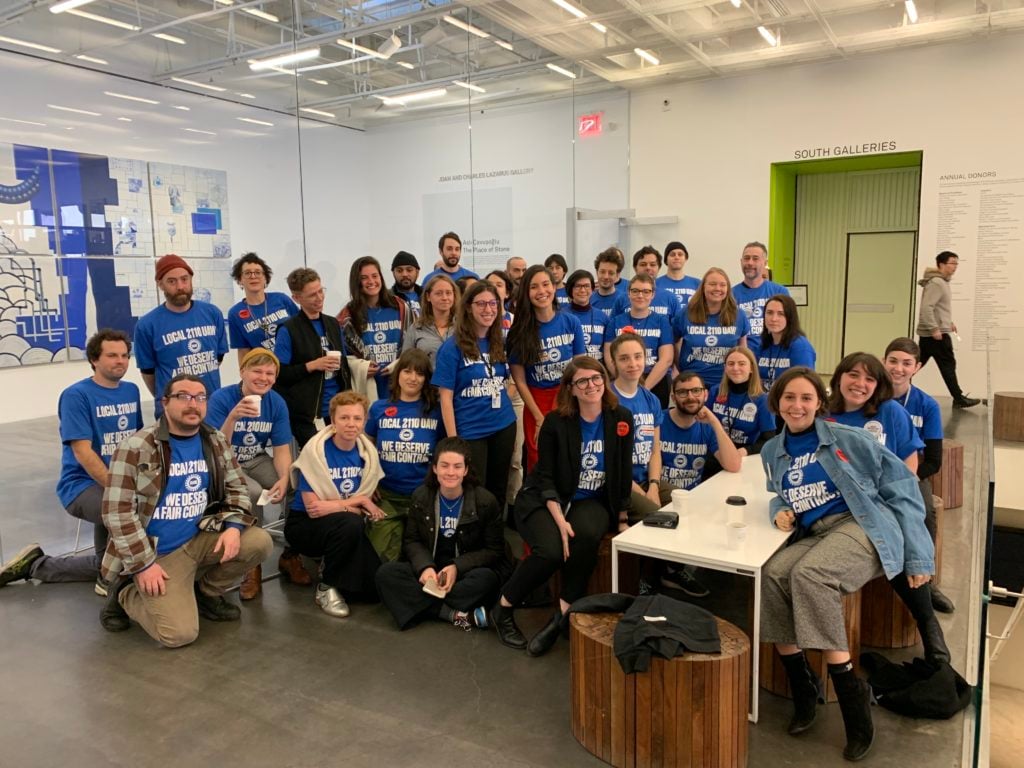
The collective bargaining unit at the New Museum. Photo by Sarah Cascone.
Now, a few new collectives are endeavoring to ensure the conversation about art and labor continues. The Art and Labor podcast, produced by O.K. Fox and Lucia Love, looks back at past labor movements, such as the Art Workers’ Coalition and the Black Emergency Cultural Coalition, and draws parallels to current movements in the art world.
Meanwhile, the collective Art & Museum Transparency—the group behind a viral art salary spreadsheet launched in May—recently debuted a new sheet dedicated to art unions, including, among other resources, contact information for organizers and a list of existing unions. “We hope that seeing them all listed there helps normalize the idea,” said representatives for A&M. The group also continues to promote individual unionization efforts online and is working to develop a watchdog system to keep track of and alert others to institutional hostility, sexual harassment, or other labor issues.
What’s Driving the Change
While art institutions continue to resist change, their current growing pains stem in part from their own attempts to diversify. “Museums have been pressured to be more inclusive and to hire people who are not coming from wealthy backgrounds,” said P., a member of A&M Transparency who maintains anonymity. “But once you start including people who are different, they’re going to expect different things from the institution. I think that’s where you see a lot of this tension and hesitation coming from, because these institutions ultimately don’t want to change at all. They just want to have the appearance of change.”
The push for diversity was invoked explicitly in a release from the unionizing MOCA workers. “We recognize that management has identified a need to shift workplace culture in order to make equity, diversity, and accessibility a greater priority,” the group said. “So far, however, this has been a top-down structure that has involved spending undisclosed amounts of money on external consultants who speak on behalf of the entire staff.”
The New Museum union fought hard for diversity protections during its contentious contract negotiations. “We’re very aware of the fact that our union is dominantly white and predominantly middle and upper class and that the people who fall outside of that are often in the most precarious and most poorly paid position,” Dana Kopel said.
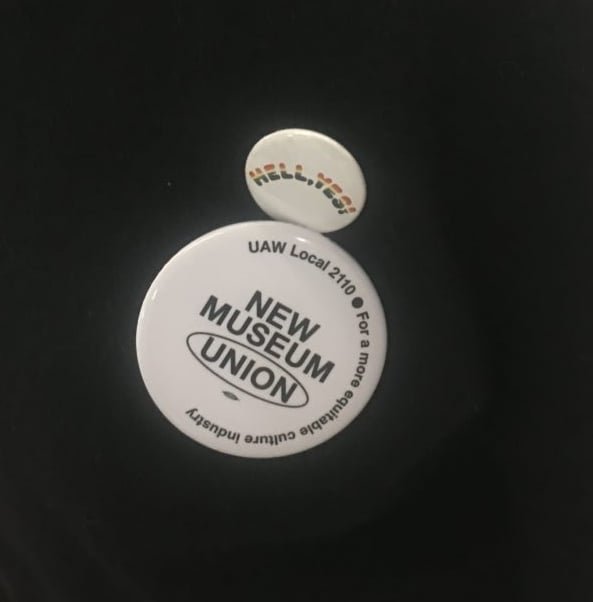
Union swag. Photo: Rachel Corbett.
The museum, whose founding director Marcia Tucker prioritized minority voices, resisted any protections for diversity that went beyond New York State law, according to Kopel. But the final contract, reached on October 1, did include non-state-mandated non-discrimination protections (including for HIV status, union status and activities, and citizenship). It also specified that, “on request of either party,” the museum and the union could meet to discuss diversity in hiring, recruitment, and promotion. “I think this is a huge cultural change that’s going to be gradual,” Kopel added.
At least in public, some museums are beginning to acknowledge that the expectations of their employees are changing. A spokesperson from the New Museum said: “Across many sectors, our country has experienced a generational shift in values and a corresponding evolution in expectations for workplace culture” and that “the museum listened closely and worked very hard to quickly reach a positive resolution.”
Nevertheless, the divides will take considerable time and effort to bridge. And for its part, the MAF union is still attempting to hold their bosses accountable. On a recent Saturday, they gathered outside LAXART, a small non-profit in Hollywood where Olivia Marciano, the MAF’s artistic director and the daughter of Maurice Marciano, sits on the board.
A child when her father and uncle thwarted mid-1990s unionization efforts at Guess by laying off organizers and moving production to Mexico and South America, she has spoken liberally about wanting art to be accessible in Los Angeles. In 2017, she told Modern Luxury Magazine, “Once you start making an impact in a good way, there’s no way to go back.”
The MAF demonstrators asked LAXART’s director Hamza Walker, who came out to meet the group in the modest courtyard, that Oliva be removed as a board member if she remained silent on MAF’s labor issues. Walker listened attentively, but later told the Los Angeles Times he does not necessarily see Olivia’s position on the board as a conflict.
Union organizer Petzold sees the situation differently. “I think a lot of it is about higher principles,” he said. “It’s acknowledging this is a whole community and there should be accountability in that community.”


Spread the word